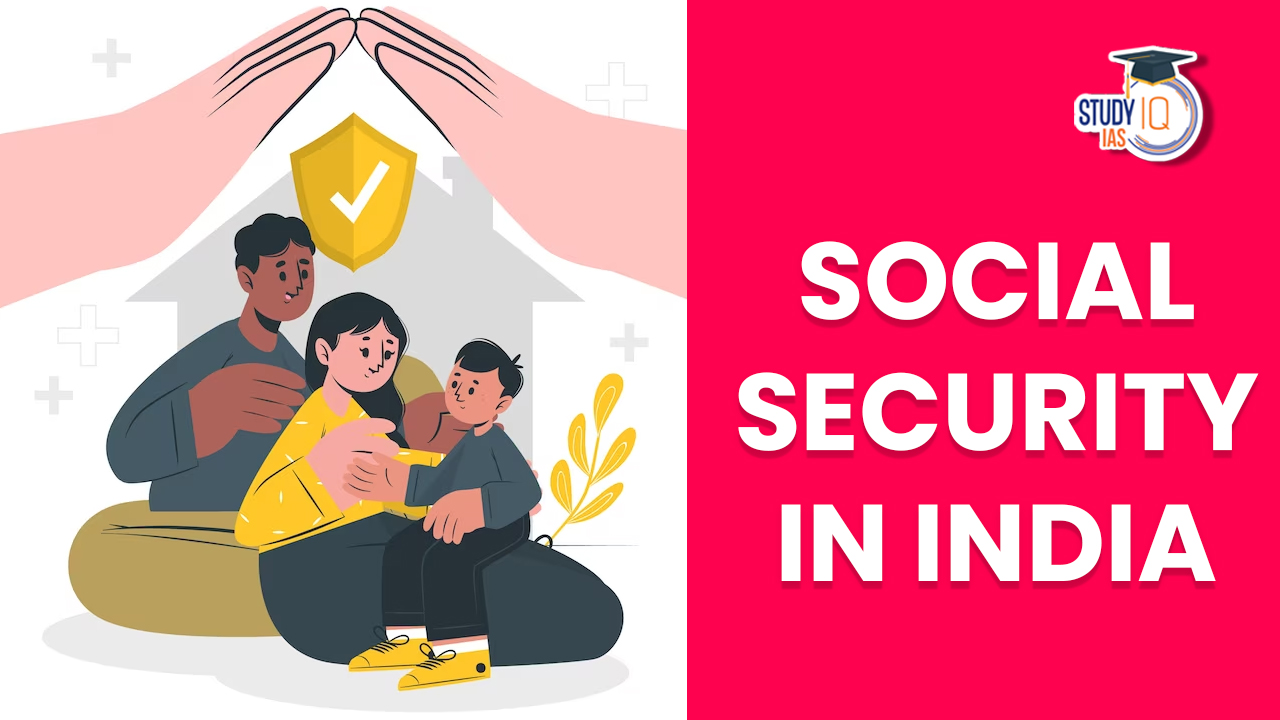Table of Contents
Social Security in India
Social Security: Social security is a human right which response to the universal need for protection against certain life risks and social needs. It covers eventualities like Sickness, Maternity, Disability, Death, Unemployment, and Old age. Social Security in India covers treatment, rehabilitation or compensation. Lack of Social Security in India or in any other nation can lead to destitution, crime, child labour, etc.
Objectives of Social Security
Compensation, Restoration and Prevention are the three major objectives of Social Security.
- Compensation implies security of income. It is based on this consideration that during the period of the contingency of risks, the individual and his/her family should not be subjected to a double calamity, thus by destitution and loss of health, limb, life or work.
- Restoration commutates cure of one’s sickness, reemployment to restore him/her to earlier condition. In a sense, it is an extension of compensation.
- Prevention measures are directed to avoid the loss of productive capacity due to sickness, unemployment or invalidity to earn.
Social Security Measures in India
In 1927, formulating a health insurance scheme received the attention of the Government of India. The Royal Commission on Labour also stressed the need for health insurance for industrial workers. The problem of health insurance was discussed in the Labour Ministers Conference in 1940, 1941and 1942 which resulted in the appointment of a committee presided over by Professor B.P. Adarkar in 1943.
BP Adarkar Committee (1943)
The committee was provided with the task of preparing details of the compulsory insurance for industrial workers. Adarkar Committee submitted the report in 1944 with recommendations based on compulsory contribution principles wherein contributions by the workers depended upon their earnings in slabs. ILO experts modified Adarkar’s report and finally, it was passed as the Employees’ State Insurance Act in 1948. Professor B. P. Adarkar developed the first Social Security scheme in India in 1944.
- The govt enacted the Employees’ State Insurance Act, 1948 (ESI Act) to set up Employee State Insurance Corporation (ESIC).
- Employees Provident Fund Act, 1952 was enacted to set up the Employees Provident Fund Organisation (EPFO).
- Some earlier schemes like Workmen’s Compensation Act (1923) paved the way for workers & families to receive benefits in case of injuries.
- The Maternity Benefit Act, 1961 provides for 12 weeks’ wages during maternity plus paid leaves.
- The Payment of Gratuity Act, 1972 provides 15 days’ wages for each year of service to employees who have worked for 5 years or more in organizations with 10 worker strengths or more.
Social Security Schemes in India
India’s social security schemes cover the following types of social insurance:
- Pension
- Health Insurance and Medical Benefits
- Disability Benefit
- Maternity Benefit
- Gratuity
There are two major social security plans in India, the Employees’ Provident Fund Organization (EPFO) and the Employees’ State Insurance Corporation (ESIC). The EPFO runs a pension scheme and an insurance scheme. All of these are supposed to grant EPFO members and their families benefits for old age, disability, and support in case the primary breadwinner dies. The ESIC covers low-earning employees providing them with basic healthcare and social security schemes.
Originally aimed at factory workers, the coverage was extended to include greater parts of the population, e.g. employees in hospitals or educational institutions. The ESI scheme has been implemented in all states excluding Manipur and Arunachal Pradesh.
Important Social Security Schemes
The Government of India has launched various important social security schemes in India. A list of Social Security Schemes in India is mentioned below in the table:
| List of Social Security Schemes in India | |
| Social Security Schemes | Details |
| Atal Pension Yojana (APY) | It is an old-age income security scheme for the working poor and the longevity risks among the workers in the unorganised sector. The Government had launched the scheme with effect from 1st June 2015. The scheme replaces the Swavalamban Yojana / NPS Lite scheme. It is administered by Pension Fund Regulatory and Development Authority (PFRDA).
Eligibility of APY
Benefit of APY
The subscriber has to contribute on monthly basis between Rs. 42 and Rs. 210, if he joins at the age of 18 years. For the same fixed pension levels, the contribution would range between Rs. 291 and Rs. 1,454, if the subscriber joins at the age of 40 years. |
| Pradhan Mantri Jeevan Jyoti Bima Yojana (PMJJBY) | It is a scheme with death coverage (Life Insurance). It is implemented by the Life Insurance Corporation (LIC). It provides life coverage to the poor and low-income section of the society.
Eligible
Benefits
|
| Pradhan Mantri Suraksha Bima Yojana (PMSBY) | It is an accident Insurance scheme under Ministry of Finance it covers Accidental death or disability coverage. It was launched in on 2015.
Eligibility
Benefits
|
| Pradhan Mantri Kisan Samman Nidhi (PM-KISAN) Yojana | Under the scheme, the government has promised a direct payment of Rs. 6000 in three equal instalments of Rs. 2000 each every four months into the Aadhar bank accounts of eligible landholding Small and Marginal Farmers (SMFs) families. |
| PM Kisan Mandhan Yojana |
|
| Pradhan Mantri Laghu Vyapari Mandhan Yojana, 2019 | The new scheme that offers pension coverage to the trading community was launched from Jharkhand.
|
Social Security in India UPSC EPFO
The Social Security in India UPSC EPFO is an important topic for the UPSC EPFO exam. As this topic is in relation to the essential functioning of the Employees Provident Fund Organisation. Its syllabus includes the important social security schemes and the legislations that have been framed by the Parliament of India as the Employees’ State Insurance Act, 1948 (ESI Act), Employees Provident Fund Act, 1952, Workmen’s Compensation Act (1923), Maternity Benefit Act, 1961, Payment of Gratuity Act, 1972.


 Daily Quiz 16 April 2025
Daily Quiz 16 April 2025
 Bhashanet Portal : Empowering Multilingu...
Bhashanet Portal : Empowering Multilingu...
 Soyuz Aircraft: History, Design and Sign...
Soyuz Aircraft: History, Design and Sign...





















